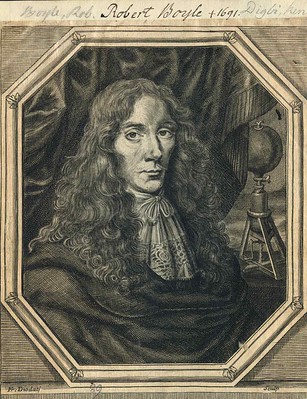Robert Boyle, one of the founding fathers of modern chemistry and a man who changed the very way we look at scientific research. From the Scientific Method to the very laws that govern gasses, Robert Boyle was able to change the very way we look at life and solve our problems. One could say that Robert Boyle didn’t really have what you would call a humble beginning; he was born in January 1627 to the 1st Earl of Cork Richard Boyle and his wife Catherine Fenton at Lismore Castle in Ireland. When he was only 8 years of age, he was sent off to Eton College in order to study under a private tutor. In 1641 Robert would spend the winter in Florence Italy studying the “paradoxes of the great star-gazer” Galileo Galilei.

Starting in mid-1644 Robert would make his residence in Dorset England were he conducted many experiments and from then devote his life to research. In 1654, Boyle would move to Oxford from Ireland in order to further pursue his studies in chemistry. It was here in 1657 that he would read about Otto von Guericke’s air pump, and would set out to improve the system along with Robert Hooke. In 1659 the “Pneumatic Engine” would be completed and he began a series of experiments on the properties of air. He would further go on to coin the term factitious airs which is a term used to describe synthetic gases after isolating what is now understood to be hydrogen.
Though he was primarily interested in chemistry, one of Boyle’s most famous discovery was what is now known as the first of the gas laws, rightfully named Boyles’s Law. Boyle’s Law defines the relationship between pressure and volume in a closed area given the mass of an ideal gas. Boyle and his assistant Robert Hooke used a closed J-Shaped tube and poured mercury in from the open side, forcing the air on the other side to contract under the pressure. After repeating this using several different amounts of mercury Boyle deducted that the pressure of a gas is inversely proportional to the volume occupied by it.

In 1669 his health, although which was never very good, began to fail seriously and he withdrew from the public. In his later days he would propose some important chemical investigations which he wanted to leave as a sort of legacy for those who would were also “Disciples of the Art”, essentially future chemists. On the winters day on December 31, 1691 Robert Boyle took his final breath. In his will Robert Boyle left a series of lectures known as the Boyle Lectures the talked about the relationship between Christianity and today’s science.
Here at EXAIR we use Boyle’s Law everyday as nitrogen, oxygen, and hydrogen (the three main elements that make up air) are all considered ideal gas. This means that all of our products are governed by the relationship between pressure and volume.
If you have questions about any of our quiet EXAIR Intelligent Compressed Air® Products, feel free to contact EXAIR or any Application Engineer.
Cody Biehle
Application Engineer
EXAIR Corporation
Visit us on the Web
Follow me on Twitter
Like us on Facebook
Robert Boyle image courtesy of Skara Kommun, Creative Commons License